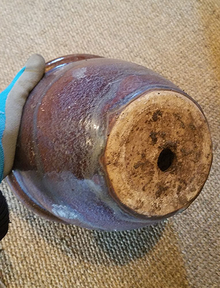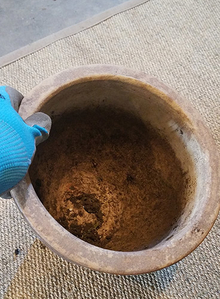Quick facts
- Dirty gardening tools and pots can spread disease from an infected plant to a healthy one.
- Properly cleaning and disinfecting tools and containers can reduce the spread of plant diseases.
- Disinfecting is important especially when working with diseased plants and plants that are susceptible to the same diseases.
Why should I clean my tools and containers?
Plant pathogens like bacteria, fungi and viruses cause diseases that can kill plants. They can be transferred to and infect plants through bits of soil and plant debris like roots stuck on a shovel, tree sap on a pruner blade, or soil left on a pot.
Sometimes it’s easy to see what you need to clean. But pathogens are microscopic and, while your tools may look perfectly clean, these microorganisms may still be on your blade or tomato cage.
Prevent the spread of disease between plants by thoroughly cleaning and disinfecting your tools, equipment and garden implements.
When should I clean my tools and containers?
- In the fall before you put them away for the winter.
- In the spring before you use them if you didn’t clean them in the fall.
- After working with an infected plant and before moving onto the next plant.
- After you use your tools at another garden site and before you use them at home.
How to clean with effective disinfectants
Clean items well before disinfecting
Dirt and debris left on tools will interfere with the disinfection process and reduce its effectiveness, so remove all visible soil and plant debris.
- Washing with water and soap or detergent will remove grease and grime.
- Use a stiff brush to remove dirt especially from rough surfaces.
- A hard spray of water or a pressurized sprayer will remove caked-on dirt from tools and get into tight spaces like between the tines of a tiller.
- Consider removing parts like the tines to clean and spray thoroughly (see your equipment manual).
- Most wood used for planters naturally repels bacteria and fungi, but it can get dirty.
- Wash wooden planters with warm, soapy water, let dry and oil or wipe with a wood preservative.
Caution about disinfectants: Chemicals used to disinfect can have harmful fumes and burn skin. Read the label, use as directed, and wear personal protective equipment like goggles and gloves when the label recommends doing so.
- Always store out of reach of children and vulnerable adults, and in a dry location with stable temperature.
- Never mix disinfectants with other chemicals.
- If used improperly, disinfectants can cause harm to the user. If poisoning is suspected, call 911 or the Poison Control Hotline 1-800-222-1222.
Active ingredient .1% alkyl dimethyl benzyl ammonium saccharinate
There are various products that contain the above active ingredient, so check the product label. One product is Lysol® All-Purpose Cleaner*. Research has shown that this formulation will eliminate bacteria, fungi and viruses from tools. This product dose not corrode metal and will not damage fabric. Do not use on polished wood, painted surfaces or acrylic plastics.
Usually comes ready-to-use
- Check the label.
- Do not dilute.
Best used on:
- Small hand tools like pruners, loppers, trowel, tree saws, pole pruners.
- Small pots and saucers, plant labels, clips, ties.
- Hard-to-reach areas like tines and blades, and ornate implements like trellises, plant stands, hanging baskets.
How to use:
- Clean all visible dirt and debris from tools including crevices.
- Dip tool, spray directly on a tool or soak tool for 2 minutes.
- Let air dry.
- Tip: Some experts pruning multiple trees advise having two pruning tools on-hand. They let one soak in the disinfectant while making cuts with the other. When they move to the next plant, they switch pruners.
*Lysol® is a registered trademark of Reeckitt Benckiser Group plc. The use of trade names is for clarity and educational purposes only and does not imply endorsement of a particular brand or product.
Bleach (5.25% Sodium hypochlorite)
Bleach is a common, inexpensive household product.
- It can damage fabric.
- It corrodes metal and not recommended for pruning and cutting tools that require a sharp edge as it can create pits and nicks in the metal.
- Dispose of bleach after use by pouring it down the sink.
Do NOT pour it in your garden as it can harm plants and beneficial soil organisms.
Make a 10% bleach solution
- Mixing one part bleach with 9 parts of water in a plastic container large enough to immerse all or part of the item.
- NEVER mix bleach with anything except water or laundry detergent as dangerous, toxic gases may be generated that can be harmful to your health and others around you.
Best used for:
- Large hand tools such as shovels, spades, rakes.
- Stakes, poles, simple trellises, tomato cages, large containers and pots.
How to use:
- Clean all visual dirt and debris from tools.
- Dip, douse or spray tools with the 10% bleach solution. This will kill fungi, bacteria, and viruses within seconds.
- Turn taller items over in the bucket to make sure all parts are treated.
- Allow tools and equipment to dry completely.
- Rub metal items with a few drops of linseed oil, Tung oil or mineral oil. Do not use motor oil as it may transfer to plants. If rust does develop, use steel wool or wire brush to remove and re-oil.
Rubbing alcohol (isopropyl alcohol, 70% concentration)
Alcohol is flammable, so take precautions. According to the Center for Disease Control, isopropyl alcohol in concentrations of 70% or more will disinfect surfaces for bacteria, fungi and viruses.
Alcohol might NOT effectively disinfect pruning tools used on apple trees infected with fire blight.
Use at 70% concentration or higher.
- See label (active ingredient) for concentration.
- Do not dilute.
Best for:
- Hand pruners, small hand tools
How to use:
- Dip, wipe or spray hand pruner blades with alcohol before moving from one plant to the next.
Tevoitdale, B.L. Fire Blight: Integrated Pest Management for Home Gardeners and Landscape Professionals. Pest Notes, publication 7414. University of California Agriculture and Natural Resources. July 2011.
Teviotdale, B.L., M.F. Wiley, and D. H. Harper. How disinfectants compare in preventing transmission of fire blight. California Agriculture, Vol. 45, No. 4, July‐August 1991.
Rutala, W.A. and D. J. Weber. Chemical disinfectants: A guide to disinfection and sterilization in healthcare facilities. Centers for Disease Control and Prevention. Accessed April 20, 2020.
Centers for Disease Control and Prevention. How to clean and disinfect schools to help slow the spread of flu. Accessed April 20, 2020.
Reviewed in 2024





